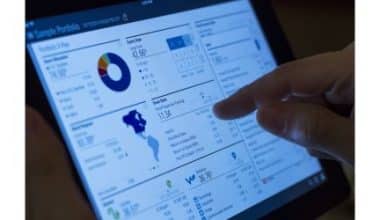A SaaS business model is a software application delivered over the Internet to provide users with easy access to their data and features. A SAAS business model is a non-physical product or service for sale through an online marketplace, cloud storage platform, or other similar platforms. Let’s have a look at a few examples of the SAAS business model and a template for creating our own.
What is a SAAS Business Model and How does it work?
A SAAS business model is an on-demand software service model that provides software and related services to customers over the Internet. Analyst Michael Farr coined the term in 2005, but it has become popular.
The key difference between this type of business and traditional models is that instead of selling licenses for specific products or services, you can subscribe instead to a subscription that entitles you to use whatever features are available depending on what kind of account you choose (e.g., basic vs. premium).
This allows businesses not only to save money but also avoid having large upfront investments in hardware or software licenses when starting because there’s no upfront cost involved.
However, some companies may still need capital funding before they’re able to make any profit from their venture – though not necessarily from subscriptions alone.
For example, suppose someone wants to only certain features within an application such as Microsoft Word. In that case, this means paying less than buying one license that includes all functions within both versions (basic vs. premium).
SaaS Business Model Examples
The following are the Saas business model examples
- Zendesk
- Salesforce
- Google Drive (G Suite)
- Dropbox (Dropbox for Business)
- Box
- Slack
- Microsoft Office 365
- Amazon Web Services (AWS).
See which of the preceding examples of SaaS business models best suits your needs.
How to Build a SAAS Business Model?
- Understand your business model.
- Identify your customers, competitors, and other companies that serve the same industry as you do.
- Consider what makes your product/service unique from others in this space (e.g., a specialized feature set or solution).
- Determine how you’ll monetize this offering (e.g., subscription-based models, freemiums, selling additional services).
SAAS Business Model Template
A SAAS business model template is a complete guide to creating your own SaaS product. You can use it to create the blueprint for your product or use it as a guide when you’re building an existing SaaS product.
What are the benefits of a SAAS business model Template?
Advantages of SaaS business model template include:
#1. Flexibility:
As a SAAS provider, you can offer your customers more than just your product or service. You can add value by providing consulting services and additional benefits such as training and support.
#2. Lower Cost of Entry:
This means that you don’t need to invest much in fixed assets like buildings or equipment because they are provided by the platform (such as Amazon Web Services). Instead, you’ll only pay for what it costs for each transaction conducted on their platform before they charge anything back to their customers’ credit cards/debit cards, etc.
#3. Less Capital
Limited capital investment is required compared with traditional brick-and-mortar businesses, where most costs related to running such companies come from wages paid out every month instead of being absorbed directly into profits generated during operation periods between sales cycles.
What Are the Challenges of a SAAS Business Model?
#1. Technical Challenges:
The SAAS business model is a technical challenge because you have to build a version of your product that can be run on an external server. It would help if you also ensured that the technology is reliable and cost-effective for your customers.
#2. Customer Support:
A big part of running a SAAS business model is ensuring that your customers are happy with their experience with the software and providing them with excellent customer support options (like live chat and email). This can be especially challenging if there are many users at once or if they’re overseas in different time zones—but it’s important for success!
#3. Product Development:
For every new feature or bug fix, you add to your software; there will be months spent creating it from scratch rather than using existing code from other services as reference material before implementing changes into their products; this process takes time but saves money by avoiding having multiple people working together on each project instead just one person doing everything themself.
Marketing and advertising cost savings potentials when compared against traditional brick-and-mortar retailing models
Scaling issues such as reaching scale without losing quality control over product offerings during the growth phase, which requires careful planning ahead, so things don’t get out completely handshakes, lol
Is Your Business Ready for a SAAS Model?
You need to be able to communicate the vision of your business clearly and effectively. You also need to know how you’re going to measure success. And most importantly, you must have a plan for making it work.
If this sounds like something that could work for your company – and if it does, then congratulations! But if not… well… don’t worry about it too much – plenty more people had tried before and failed spectacularly at least once along the way (and some even more than once).
What Is the Difference Between SaaS, PaaS, and laaS?
SaaS, PaaS, and IaaS are the three most common models to deliver a cloud-based software product
To help you differentiate between these terms: A software as a service (SaaS) offers an end-to-end solution that integrates into an existing IT environment.
In contrast to traditional deployments where IT teams have hired developers to build custom applications or systems from scratch, SaaS solutions are designed from the ground up using pre-built components to reduce costs while improving the efficiency and scalability of applications over time.
Is Zoom a SaaS?
Zoom is not technically considered a “solutions” company—it’s more like an eCommerce platform that provides tools for working with social media marketing campaigns so businesses can easily manage their brand presence on platforms such as Facebook & Instagram. However, if you want something easy-to-use but still powerful, this might be worth checking out!
What Is a B2B SAAS Business Model?
THE B2B SaaS business model is a software as a service (SaaS) business model in which the primary customers are businesses rather than individuals. Examples of B2B SaaS companies include Salesforce, Zendesk, and Dropbox.
A successful B2B SaaS business model benefits from these key strengths:
The seller can scale their product offerings and services to meet their customer’s needs by building relationships with companies that can provide additional services or products for them (e.g., marketing agencies).
This also allows for more flexibility in pricing because there aren’t any upfront costs associated with setting up an account with your tech team; instead, all you have to do is pay monthly fees based on usage levels, as discussed above!
Why Is SAAS a Good Business Model?
SaaS is a great business model for startups and small businesses because it’s easy to start, scalable, affordable, and flexible.
It’s also secure because you don’t need to worry about your IT department or servers being hacked. All the data is stored in one place (the cloud), so there are no worries about hacking the system or losing data in transit (like when uploading files).
How to Make Money with a SaaS Business Model
You can make money with your SaaS business model in many different ways. The first is by charging customers for the service you provide them, which means charging them an annual or monthly subscription fee. You also let users pay monthly fees if they want access to all of your features without having to pay anything upfront (like when using an app).
The second way involves getting paid in some other way than paying a fixed amount per month or year—for example, by taking on advertisers who want their products advertised on your site; by selling data about how many people use certain features so that advertisers can target specific demographics better; or even simply through affiliate marketing sales where someone else pays for advertising costs (like Google AdWords) and then gives a commission back towards helping keep costs down for yourself as well as keeping things profitable throughout each transaction cycle.
Examples of SAAS Businesses (Model)
Here’s a list of the most popular examples of the SAAS business model(s) and their services:
- Netflix: A streaming service that offers movies, TV shows, and original content.
- Zoom: A video conferencing service that allows users to connect with other people around the world via video chat.
- Dropbox: Provides cloud storage for files, photos, and videos. The company was founded in 2007 by Drew Houston, who continues as CEO today.
- Salesforce: Allows more than 175 million people to use CRM software to manage customer connections, including lead creation and contact management.
Is Netflix a SaaS?
Netflix is a subscription-based SAAS business. Netflix allows customers to stream movies and TV shows on computers, tablets, and phones. The company’s content delivery network (CDN) delivers videos rapidly over the Internet without relying on local servers near you.
Netflix offers other services such as DVD rentals, digital downloads, and more!
Who Uses the SaaS Business Model?
SaaS companies are typically high-growth and have a large customer base. The model is attractive to companies that want to focus on their core competencies, as they don’t need the infrastructure of a traditional IT department and can be scaled up quickly.
SaaS is also an option for companies with hundreds of thousands of customers who want access to all their products through managed services rather than purchasing individual licenses or subscriptions.
What Are the Disadvantages of the SaaS Business Model?
There are a few disadvantages to the SaaS business model. The first one is that it’s difficult to scale your company, especially if you have a large customer base. Your idea for a new product or service may not scale up if you lack money and people.
Another disadvantage of using this business model is that it requires heavy investment upfront before any revenue starts coming in. This could include setting up offices, hiring employees, buying equipment, etcetera which can be expensive!
However, there are also some advantages when compared with other models, such as franchising, where all expenses are taken care of by someone else instead of taking responsibility yourself. This also requires extra work on top of what would usually happen under traditional ways; however, these factors should not discourage anyone from trying something new!
What Are the Advantages of the SaaS Business Model?
SaaS allows you to own your customers and manage their demands, making it an excellent business strategy. You don’t have to worry about infrastructure or scaling up because you can focus on product development instead.
This model is easy to understand and explain because it has fewer moving parts than other models (e.g., monthly subscriptions). It’s also easy for investors or customers to see the benefits of this type of business model:
You get paid each time someone uses your product/service.
You don’t need a large amount of money upfront, which means less risk for them (and therefore lower costs)
How to Create Your Own SaaS Business Model
The business model canvas is a tool you can use to create your own SaaS business model. It’s a straightforward method for visualizing your business’s essential components and understanding their interdependencies.
The first thing you should do is create a business model canvas template, which will allow you to organize all of these different elements into one place, so they’re easy for anyone who wants access to them (whether or not they’re involved in the creation process). This template can help you learn from others’ SaaS business-building experiences.
Who Should Consider Using A SaaS Business Model?
If you’re looking for a SaaS business model and don’t want to invest in infrastructure, this might be the one for you.
If your company has many customers, it’s worth considering a SAAS business model because it allows you to scale quickly. In contrast, if your company only has one or two clients or employees at the moment (or none), then an on-premise solution may be more appropriate.
How To Build a SAAS Business Model (Plus Examples)
Before you start trying to solve your problem, it’s important to define the problem. What is your goal? This will help guide your business model and help you focus on what matters most.
Don’t worry about other people’s goals either—you can always choose different ones if that makes sense for your situation, but don’t let others’ ideas influence yours too much! The best way to start thinking about how much money or time it would take to reach my target weight (for example) is by looking at my experience and seeing how much progress I made in the last year.
If I did three months of cardio each week and lost 10 pounds over those three months, my current weight would be 120 instead of 130 pounds based on what I’ve been doing lately. Once we have a clear picture of where we want our lives/businesses/careers going within a 3-6 months time frame (or whatever timeline works best), then we can use this information when designing our SAAS business model so that there won’t be any surprises later down the road!
From Idea to Plan to Reality (One Step at a Time)
#1. Start with a simple plan.
Before you do anything else, figure out what you want to achieve and how you will get there. This is the first step in building your business model—it’s important that every step of the way, from idea generation through implementation, be rooted in this central idea of what it is you want your project/service/product/etc.,
#2. Get feedback from others.
Once again, feedback is key! You don’t have time or resources available right now, so make sure that whatever plans you make are based on data-driven decisions further down the road (you know who they are). Don’t just assume something works; test it out first!
#3. Use Templates to Help You Create Your Plan
Templates are a great way to get started. Having a template can help you plan your SaaS business model and create a financial model and marketing plan.
If you’re unsure how to use them or what templates are available for free, check out our resources page for more information on this topic!
I believe that the SAAS business model plus examples were helpful.
Is Amazon a SaaS platform
The SaaS business model is a great way to start a business. It’s not always the right choice for every business, but it’s worth considering if you’re looking to start your own company and don’t want to deal with having customers pay upfront.
The SaaS (software as a service) model involves selling access to software rather than purchasing physical copies or buying licenses outright. For example, You can buy an account on Adobe Creative Cloud to access all of its tools, such as Photoshop and Illustrator, without having any actual software on hand in your office (this is called “software”).
Is Facebook a SaaS?
Facebook is a SaaS business model.
Facebook was created in 2004 as an online social network for college students. The company quickly grew and expanded its services to include other products, such as photo sharing and video sharing.
In 2014, Facebook announced that it would offer developers the ability to build apps using their platform’s API (application programming interface).
This change allowed third parties to create their applications on top of the existing infrastructure built by Facebook itself; these apps would then be available through the official app store within Facebook’s website or mobile app stores like Google Play Store and Apple App Store, respectively.
To Wrap Up
SaaS can be a great business model if you have the right idea, but it does take time to get started and make money. It’s also important to keep track of all the expenses involved in running a SaaS company so that you don’t fall behind on your bills or lose money from unexpected costs.
But once your company is established and making a profit from customers who love what they’re getting through your product or service, then why not consider going public?
You’ll be able to reach out to new audiences and expand at an even faster rate than before—plus, investors will have less risk when investing in new businesses like yours because they know how profitable their investment could become!
I hope this piece on the SaaS business model template and examples was informative.
SAAS Business Model FAQs
Is Facebook a SaaS?
Facebook is a SaaS business model.
Facebook was created in 2004 as an online social network for college students. The company quickly grew and expanded its services to include other products, such as photo sharing and video sharing.
Who Should Consider Using A SAAS Business Model?
If your company has many customers, it’s worth considering a SAAS business model because it allows you to scale quickly. In contrast, if your company only has one or two clients or employees at the moment (or none), then an on-premise solution may be more appropriate.
What are SaaS business examples?
examples of Saas business model include Netflix, Zoom, Dropbox, Salesforce, etc.
What is the SaaS business model template?
SaaS business model template
- Start with a simple plan
- Get feedback from others, etc.
- Saas Marketing: Overview, Plans, Agencies and Strategies (Updated)
- Saas Sales: Ultimate Guide to The Saas Sales Process and Metrics
- REVENUE MODELS: Meaning, Practical Examples, Types (Detailed Guide)
- 10 Tips for Marketing Your SaaS Business Online
- SALES COMMISSION STRUCTURE: 2022 Templates & Examples






